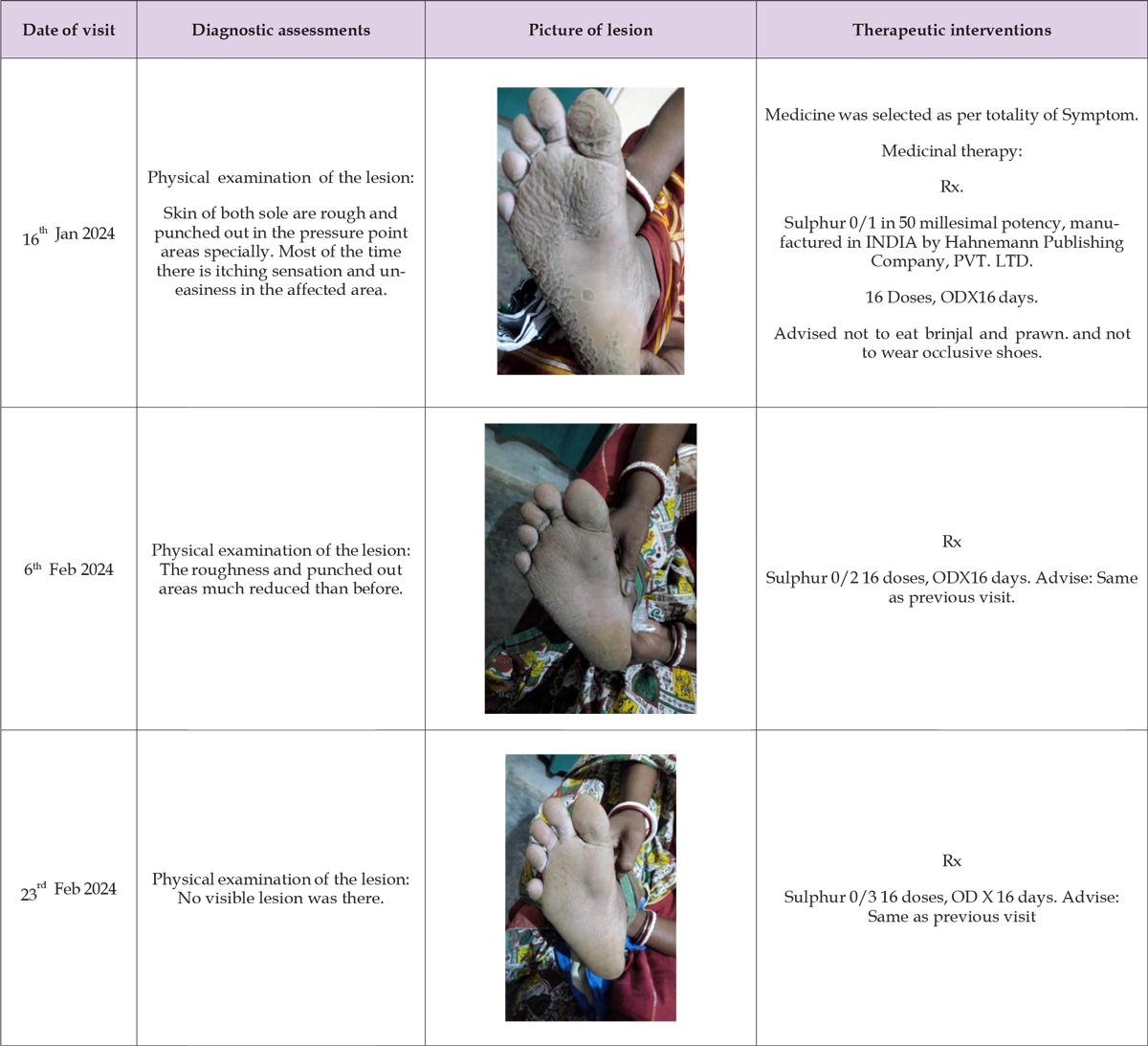Impact Factor : 0.548
- NLM ID: 101723284
- OCoLC: 999826537
- LCCN: 2017202541
Amit Gunin1* Satyajit Naskar2 and Suhisna Das3
Received: September 02, 2025; Published: September 19, 2025
*Corresponding author: Amit Gunin, Lecturer, Department of Organon of Medicine, Metropolitan Homoeopathic Medical College and Hospital, West Bengal, India
DOI: 10.26717/BJSTR.2025.63.009873
Pitted keratolysis (PK), a manifestation of keratin digestion in skin commonly found in soles. The affected sole looks very unsightly and rough on feeling due to diphtheroid organisms in skin. This case report of PK treated with Individualistic Homoeopathic medicine (IHM) shows significant positive evidence-based documentation of effect of IHM. A female, aged 38 years presented with complaint of punched out skin lesions in both soles since more than 2 years. She opted for conventional medicine, but got very less relief. After detailed case taking, repertorization and consultation with Materia Medica, Sulphur was prescribed in fifty-millesimal potency, and continued as per the response of the medicine upon patient. The patient was relieved of the complaints within 1 month of Homoeopathic treatment, and was with no complaints after a follow up of 2 and half months.
Keywords: Pitted Keratolysis; Individualistic Homoeopathic Medicine
Pitted keratolysis’s are manifestation of keratin digestion most commonly caused by gram-positive kytococcus sedentarius (Corynebacterium species) organisms in epidermis. Hyperhidrosis, hot humid weather, soggy basements are predisposing factors. Adolescent males are most commonly affected [1,2]. Clinically patient comes with small 1–7 mm crater-like depressions (shallow round pits) in the stratum corneum on weight-bearing regions of the soles of the feet and rarely the palms, pits may coalesce to large craters or rings of ratters in persons who use occlusive shoes. Most of the time soles feel tender on walking [1]. Hyperhidrosis and malodour are common presenting manifestation.
Demographic Information of the Patient
A Hindu lady of 38yrs age residing in South 24 parganas district of West Bengal, Homemaker, presented with punched out skin lesions in both sole since more than 2 yrs. On detailed enquiry no probable manifest exciting or maintain cause was traced. Onset was gradual. She had taken allopathic medicine along with application of ointments for above complaint, but with temporary relief.
• Past History: Measles, Chicken pox in childhood
• Family History: Father – suffering from diabetes mellitus. Mother is suffering from Rheumatism.
• Personal History: She had good marital relations, good relation with family members. Living in a dry, well – ventilated environment.
Generalities
Mentally the patient was mild, soft spoken, who likes company. She was anxious about the malignant potential of the lesion. General aggravation from cold and amelioration by warmth. Thermal reaction was hot. She had increased appetite, can’t tolerate hunger resulting in feeling of weakness. She had desire for sweet, intolerance to prawn and brinjal resulting in itching lips. Her thirst was moderate (2-3 lit/ day). Tongue was moist, thin white coating, having imprint of teeth. Perspiration was profuse, offensive, on whole body, especially on head.
• Clinical Examination: Face: Anxious, Built: Average, Nutrition: Average.
• Height: 156 cm, Weight: 58 Kg, Temperature: 98.40 F. Built: Normal, Anaemia: Absent, Jaundice: Absent, Oedema: Absent, Lymph node swelling: Nil.
• Respiratory System: Bronchial and vesicular breath sounds audible, no added sound.
• Respiration Rate: 18/minute, Cardiovascular system: S1, S2 audible. Pulse Rate: 80 bpm. Blood Pressure: 110/70 mm of Hg. Nervous system: Patient is Alert, conscious, all superficial and deep reflexes are normal.
• GI system: Tongue coated white. Peristaltic sounds are normal
The following characteristic symptoms were considered for repertorization:
1. Anxiety about health
2. General aggravation from cold
3. Intolerance of hunger causes feeling of weakness
4. Desires sweets
5. Offensive perspiration over whole body
6. White coated tongue
7. Desquamation on sole
Repertorization was done using Firefly Software (complete repertory) [3] and the repertorial result is shown in Table 1.
First prescription: Final selection of medicine was done after consulting materia medica [4,5] on 16th Jan 2024, Sulphur 0/1 in 50 millesimal potency 16 doses. On subsequent follow-ups, potency was changed based on the assessment of improvement subjective symptoms [6].
As there is no system for scoring the severity of plantar PK, treatment was planned according to the clinical appearance of lesions, depending on the anatomic extension of lesions, the hyperkeratosis and depth of the pits [7]. Follow-up of the patient was assessed fortnightly or early if required. The date-wise detailed follow-ups are summarized in Table 2.
Table 2: Follow ups: are presented in a tabular format along with the photographs in the following table.

Homoeopathy treats the person as a whole, and annihilates the disease manifestations (signs and symptoms) in its whole extent. In this case report, a single case showing remarkable improvement within 1months by IHM on PK whereas patient was suffered more than 2years with conventional treatment. The Modified Naranjo Criteria score (Table 3) [8] after the treatment was 10, which clearly shows the definitive role of the IHM in treating PK within 1 month when prescribed on the basis of comprehensive homoeopathic principles along with psychological care and education about the disease. However, as this is a single case study of PK further study on a large scale on this subject is needed to established the fact. This case report is done according to the HOM-CASE and CARE guidelines.
Prior to initiation of treatment the patient was greatly anxious about the curability of her disease. The treatment with IHM not only relieved her from the chief complaints i.e., PK but also the auxiliary symptoms.
The authors certify that they have obtained all appropriate patient consent forms. The patient has given voluntary consent for her images and other clinical information to be reported in the journal. The patient was informed that her name and initial will not be published, and due efforts will be made to conceal her identity, but anonymity cannot be guaranteed.


